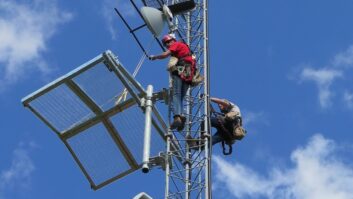The author is president and CEO of the Consumer Technology Association.
Recently, our organization’s governing board gathered at a stunning hotel in Napa Valley. I remember marveling both at the beauty of the location and the high-tech accommodations. The rooms had the most up-to-date, cutting-edge innovations – down to the toilet that automatically raised its cover as soon as you set foot in the bathroom.

Gary Shapiro
The last night of the trip, however, neither the stunning views nor the high-tech accommodations mattered much to any of us. Wind gusts swept through the area, rendering everything in the room – from the lighting and the internet to the toilet cover – completely useless. Bleary-eyed and tired, we gathered outside munching on delectables from the hotel’s powerless refrigerator as we considered our options.
The hotel was incredibly helpful, considering the circumstances, serving food and sending candles to our rooms. But reports of standstill traffic were circulating, and many of us began to wonder if we would be able to leave. I knew I’d have a hard time packing up to go: My suitcase was on my room’s patio, which was now inaccessible to me because the super heavy patio shades were powered by electricity.
I decided we should start our morning meeting earlier than planned. I let board members know by knocking on their hotel room doors. Apart from one pregnant mother, an elderly couple and those who had flights to catch, everyone sat together in a conference room and hashed out ideas – no smartphones, no computers, no electricity and no coffee. It ended up being a valuable meeting on a critical subject.
This experience transformed the way I think about technology. Like most Americans, I rely on the digital devices and appliances around me, whether it’s my step tracker, smartphone or tablet. In one sense, it’s empowering – but it also leaves me vulnerable. Unless my devices have some sort of backup capabilities, it’s easy to feel helpless when technology stops working. If there had been a fire at my front door, the electric-powered blinds meant I couldn’t escape via the windows or door to the patio.
Disasters like those we’ve seen this fall – whether it be the fires in Napa Valley or the hurricanes that swept through Texas, Puerto Rico and Florida – have crucial lessons for users of technology. Consider backup plans for when the products break or electricity or telecommunication systems go down. Technology sometimes fails.
Consumers always face choices. This isn’t like flying where you can and should assume airlines have redundancy like a second airplane engine. Redundancy is more important when safety is vital, than when consumers can choose it for convenience.
Every home and hotel should have a hand-crank flashlight for the times when power is lost. When buying smart home locks and thermostats, ask about what happens with the loss of electricity. Is there a backup battery? Is there a manual backup?
Every business should have a hand-crank or solar radio, or a phone with a working FM radio option. Consumers could choose smartphones with an FM radio function. Radio broadcasters would be wise to promote those phones that contain a working FM receiver.
As we determine which technologies guide our self-driving cars – car-to-car communication, GPS, on-board computers, smartphone-based spectrum – we should bear in mind the importance of redundancy. Better to test and perhaps incorporate redundant self-driving features than to have only one and watch it fail.
Redundancy may sound costly, but it doesn’t necessarily have to be. When the industry was debating how to effectively transition to high-definition TV, each proponent wanted their proposal with different technical attributes to become the mandatory standard. When I learned it was inexpensive per chip to make a high volume of chips that could display every format, I pushed for that chip to become the standard. All parties agreed to it, and the shift to the national HDTV system went smoothly, naturally and inexpensively.
More, situations like the one in Napa have important lessons for consumers. I never thought I would need or want to carry a flashlight – after all, I have one on my phone. But when I saw how quickly the flashlight ate up my cell phone charge and realized that I couldn’t recharge my phone, I was reminded of the importance of a basic level of redundancy.
My hope is that companies and consumers alike will see these crises as an opportunity to plan ahead and consider how they can implement the kind of redundancies that will prevent them from being totally reliant on technology.
The silver lining of the whole situation? I could flush the toilet manually. Thank goodness for redundancy.
Gary Shapiro is president and CEO of the Consumer Technology Association (CTA)®, the U.S. trade association representing more than 2,200 consumer technology companies, and author of the New York Times best-selling books,Ninja Innovation: The Ten Killer Strategies of the World’s Most Successful Businesses andThe Comeback: How Innovation Will Restore the American Dream. His views are his own. Connect with him on Twitter:@GaryShapiro
A similar version of this article appeared in Recode on Nov. 9.












